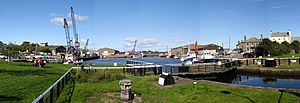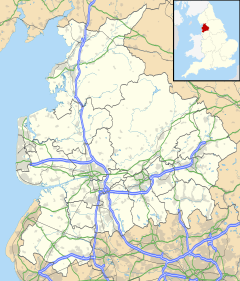Glasson Dock facts for kids
Quick facts for kids Glasson Dock |
|
|---|---|
 The lock at Glasson Dock |
|
| OS grid reference | SD443561 |
| Civil parish |
|
| District | |
| Shire county | |
| Region | |
| Country | England |
| Sovereign state | United Kingdom |
| Post town | LANCASTER |
| Postcode district | LA2 |
| Dialling code | 01524 |
| Police | Lancashire |
| Fire | Lancashire |
| Ambulance | North West |
| EU Parliament | North West England |
| UK Parliament |
|
Glasson Dock, often just called Glasson, is a small village in Lancashire, England. It's located south of the city of Lancaster, right where the River Lune meets the sea. In 2011, about 600 people lived there.
Contents
History of Glasson Dock
Glasson started as a small village where people farmed and fished. This older part is now called Old Glasson and Brows-saltcote. The village of Overton is just across the river from Glasson.
Building the Dock
In 1779, the Lancaster Port Commission decided to build a dock at Glasson. This was because it was hard for ships to sail all the way up the River Lune to the port in Lancaster. Land was bought in 1780, and work began in 1782.
A pier was built first, but there were problems with one of its walls. In 1782, the commission asked Henry Berry, an engineer from the Liverpool docks, to help. He was too busy, so Thomas Morris was asked instead.
Morris drew up plans in 1783. His plan included fixing the wall and building another short pier. This would allow gates to be fitted between the two piers. The project was estimated to cost £2,700. Construction finished in March 1787, and the dock opened. It was well-equipped and could hold up to 25 merchant ships.
Connecting to the Canal
In 1792, as the Lancaster Canal was being built, people thought about connecting it to the dock. John Rennie's plans for a Glasson branch line were approved in 1793. However, no work happened for a while.
The plans were brought back in 1819, and work finally started in 1823. The branch was about 2.5 miles (4 km) long. It dropped about 52 feet (16 m) from Galgate to the dock. The main engineering work was done by December 1825.
At first, there were money problems, so warehouses and wharves couldn't be built. This meant trade grew slowly. However, by 1830, over 10,000 tons of goods passed through the dock. Most of these goods then traveled on the canal.
Because the canal locks were 14 feet (4 m) wide, smaller ships could sail right through the dock and onto the canal. They didn't have to move their goods to smaller canal boats. The first ship to do this was a schooner called Sprightly in May 1826. It carried slate to Preston. Goods coming in included slate, timber, potatoes, and grain. Coal was sent out from the port to places like Ulverston, North Wales, and Ireland.
Village Growth and Changes
The ships using the dock didn't need many local workers. Because of this, the village around the dock didn't grow very fast. Many buildings in Glasson were built in the 1800s. This includes Christ Church, which was built in 1840.
A shipyard and a Customs House were built in 1834. A Watch House was added in 1836, and a Dry Dock in 1841. The shipyards mostly repaired ships rather than building new ones. They closed in 1968, and the dry dock was filled in a year later.
The dock was connected to the railway in 1883 by a 5-mile (8 km) branch line to Lancaster. Passenger trains stopped running on this line in 1930. Goods trains continued until 1964. Today, the old railway line is a path for walking and cycling. It's part of the larger Bay Cycle Way.
Modern Dock Use
Even today, some commercial ships still use the dock. Coal is shipped out to the Isle of Man and the Western Isles of Scotland. Animal food and fertilizer come into the dock. These goods are stored in large sheds by the dockside.
Ships Built in Glasson Dock
Some ships were built in Glasson Dock, including:
- Anna (1835)
- Carrie Bell (1862) built by Matthew Simpson
- Englishman (1864) built by Matthew Simpson
- Dairy Maid (1867) built by Matthew Simpson
- James & Mary (1867) built by Matthew Simpson
- Red Rose (1879) built by Matthew Simpson
How the Dock Works
Ships can only enter the dock at certain times when the tide is high. This is because the River Lune has very little water when the tide is low. It's not safe to moor ships outside the dock entrance at low tide.
The dock gates only open for a short time around high tide. This period starts 45 minutes before high water and closes at high water. Traffic lights control entry to the dock. Sailing down the river is only safe for about an hour right after high water.
Glasson Basin Marina
The dock is connected by a lock to the Glasson Basin Marina. This marina has places for 220 boats to moor. It also offers many services for boat owners. These include a shop for boat supplies, repair facilities, a wet dock, and a slipway. There's also a hoist that can lift boats weighing up to 35 tons.
The Victoria Inn
The Victoria Inn is one of the village's public houses, or pubs. It's a historic building with a Grade II listed status. This means it's recognized as an important building that should be protected.
In 2019, the owners planned to change the building's use. They wanted to have a bar only on the ground floor. The first floor would have two holiday apartments, and the second floor would have two residential apartments.
The building is made of stone covered with rendered material and has a slate roof. It has three floors and a balanced front with three sections. The outer sections have two-story canted bay windows. The windows on the lower two floors are sashes. The main doorway in the middle is simple.
Gallery







